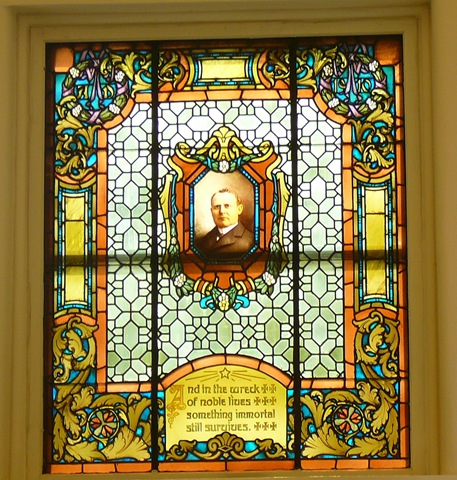Tuesday, October 28, 2008
Saturday, October 25, 2008
Saturday, October 18, 2008
Tuesday, October 14, 2008
the moon Monday, October 13, 2008
was gorgeous......all these strange clouds surrounding it in circle....yellows and blues.......the colors do not show up true here but are very close. It was beautiful!
Saturday, October 11, 2008
second stained glass artwork in the library NOT in a window.....
I know this is not an ideal shot..the library was actually pretty busy the day I was there and I felt a little odd trying to snap photos with all the people wondering what I was doing. I know I have a better shot of this on another drive...but I don't have time to get it now.
The newly remodeled library in Greenville, Ohio.....the front and two new wings to the sides.......
A very nice reading/researching/studying area by a new gas fireplace!
lots of ornate architecture still remains.....
with new sculptures throughout....as well as some old pieces......
Here is a history of the library which is rather interesting....
- A history of the library
- Correspondence of Andrew Carnegie and the Greenville Board of Education regarding the new building
- Resolutions of the Greenville Board of Education and the Greenville City Council providing for support of the library
- A list containing the names of President Theodore Roosevelt and his Cabinet and the presiding officers of the U.S. Senate and House
- A list of state officials and different boards of the City of Greenville
- The Greenville Board of Education, its committees, officers and teachers of the schools
- A list of Darke County officials
- A list of Masonic officials
- An account of the assassination of President William McKinley and his last address
- Copies of the eight newspapers being printed in Greenville at that time (Greenville Journal, Greenville Democrat, Daily Advocate, Daily Tribune, Democratic Advocate, Weekly Tribune, Deutsche Umschau, Greenville Courier)
- A copy of the report of the city school, the librarian’s report and a copy of the cornerstone ceremony
1903 -- March 19, the building was dedicated.
Funding for the construction was as follows:
- $25,000 donated by Andrew Carnegie
- $3,610 donated by Henry St. Clair
- $7,175 donated by School board
- $35,785 total donations
Miss Lucy Arnold, librarian, had the honor of carrying in the first book, the Bible.
1972 -- The Carnegie Public Library changed its name to Greenville Public Library.
1989 -- After an elevator was installed, the upstairs attic was renovated into the office area.
ARCHITECTURAL HISTORY
BUILDING
Constructed of bedford stone and buff-pressed brick, with a red tile roof. The expansive lawn is shaded by sycamore, elm and buckeye trees.
FICTION ROOM
Formerly the Children's Room.
NONFICTION ROOM
This room has remained the same for years. It has always been the Nonfiction Room.
REFERENCE ROOM
Above the fireplace, a mural painting of Learning, a woman in flowing robes holding the literature of the world on her arm. In a niche in the all is a beautiful marble statue of History with an open book and pen in her hand. Brought from Italy by Mr. and Mrs. St. Clair. On a pedestal beside the fireplace was another Italian marble statue, the Muse of Music, Polyhymnia, donated Brigadier General Sigafoos. Between the Reference Room and the Biography/900 Room is a stained glass window showing William Shakespeare. Next to the fireplace is a stained glass window showing Henry St. Clair.
BIOGRAPHY/900 ROOM
Formerly the public reading room which contained current magazines and history books.
Formerly Public Reading Room (Currently Biography / 900 Room)
MAIN LOBBY
There was a skylight in the ceiling, which consisted of a stained glass panel over a white background. Incandescent lighting was available but seldom used. When renovation to the attic was done, the skylight was unfortunately covered. To this day, staff members still wonder what happened to the stained glass panel. Was it left in place, covered by a wood panel and paint, waiting to be rediscovered by future generations? We may never know….
The walls were originally frescoed in tans and brown. In the arches, these words were written:
- "I have taken all knowledge to be my province." -- Bacon
(over entrance to Non-Fiction Room) - "In everything you do consider the end." -- Solomon
(over windows into Fiction Room) - "The fear of the Lord is the beginning of knowledge." -- Old Testament
(over the windows into the Biography/900 Room) - "In books lies the soul of the whole past time." -- Carlyle
(over entrance to the Reference Room)
MAIN FLOOR MEETING ROOM
Underneath the off-white paint lies a fascinating Egyptian motif on the upper walls and ceilings.
The room is now used for Children's Story Hours, Teen Advisory Board Meetings, library programs and public meetings, but has had many functions in the past. Over the years it has served as the Director's Office, Genealogy Room, and a Book Sale Room.
DOWNSTAIRS LEVEL
For a while, the entire floor was used as a museum until 1946.


























